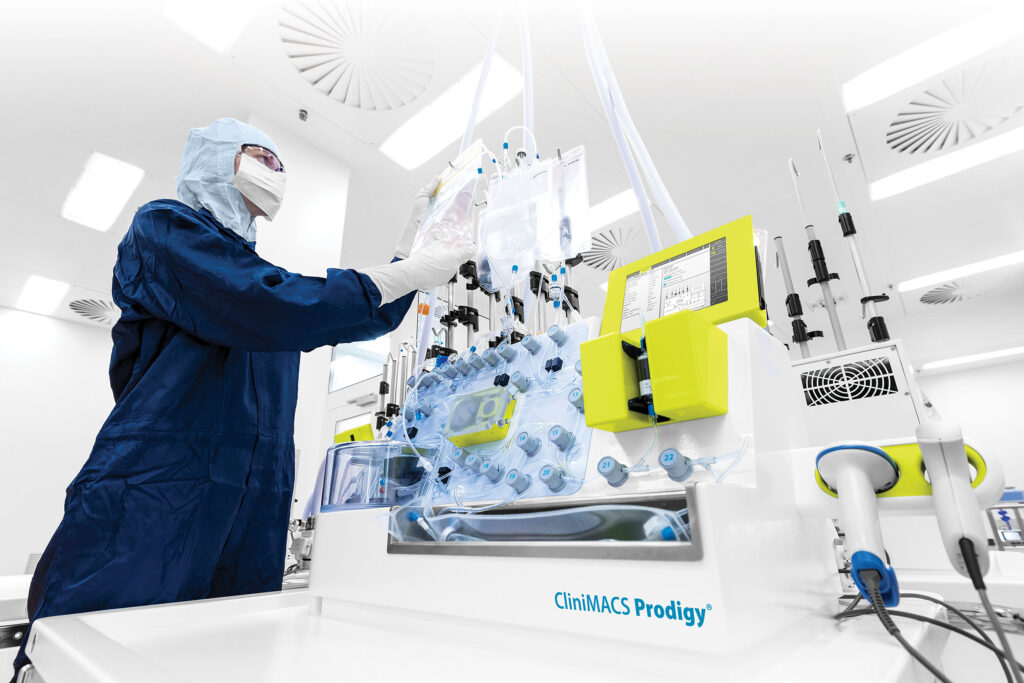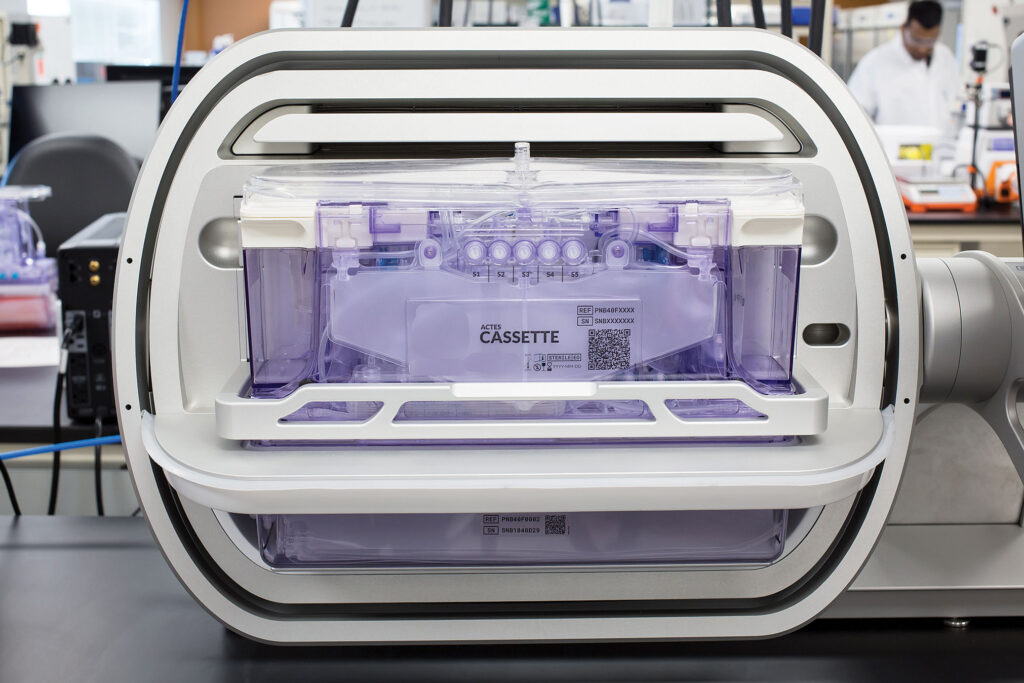As the cell therapy industry continues to grow, it must face the challenge of creating products that are not only safe and effective, but also affordable. Currently, the prices for approved products ($0.4–2 million) are too high for most patients, largely because of labor costs, which account for about 50% of the cost of goods in cell therapy manufacturing.
Fully automated cell therapy manufacturing processes could significantly reduce manual intervention and human errors, supporting robust processes, improving product quality, speeding product delivery, and reducing costs. In this article, we will discuss how automated cell therapy manufacturing processes may be achieved with new bioreactor and sensor technologies.
Bioreactors
Bioreactors are vessels that permit the careful control of parameters like pH, dissolved oxygen, and temperature to ensure that cells are optimized for cell growth. Bioreactors should culture cells at sufficiently large scales to address the need for cell therapies that can deliver 108–10 cells/dose.
In 1944, de Becze and Liebmann created the first bioreactor for compressed yeast production. The first bioreactor designs were large stainless-steel tanks, the bases of which were connected to pipes that could introduce air. Subsequent designs introduced impellers that could facilitate mixing and air bubble dispersal. Eventually, designs were modified to address the requirements of the food and biopharmaceutical industries. For example, designs began to incorporate antiseptic features and real-time monitoring.
Today, various types of bioreactors with special features are commercially available. Bioreactors that are commonly utilized for cell manufacturing include rocking bed, stirred tank, packed bed, and rotating wall vessel bioreactors.
The most commonly used bioreactor for bioprocessing is the stirred tank bioreactor, which is capable of scaling to large volumes (maximum volume: 20,000 L) of cell culture. However, in the stirred tank bioreactor, cell cultures are homogenized using an impeller that turns so vigorously it can affect biological processes. For example, turbulent flows and large shear forces have been found to induce the undesirable, spontaneous differentiation of stem cells.
To minimize the effects of shear forces in bioreactors, researchers developed the rocking bed bioreactor. It uses wave-like motions to ensure low shear stress and to achieve efficient nutrient diffusion. Low shear stress, researchers have found, is crucial for maintaining high cell quality.
Another bioreactor that has similar advantages for culturing sensitive primary cell lines but typically in smaller volumes (<10 L) is the rotating wall vessel bioreactor. As the name suggests, the cells are cultured inside a vessel that is rotated to produce a free-falling state. However, this system requires a complex control system to create precise rotation speeds to induce a free-falling state for continually growing cell populations. For both rocking bed and rotating wall vessel bioreactors, scalability is a challenge.
The aforementioned bioreactors are suitable for culturing non-adherent cells such as immune cells for cancer immunotherapy, but when it comes to adherent stem cells, microcarriers are required. However, the need to completely remove dissolvable microcarriers in the later stages of bioprocessing can lead to technical challenges and regulatory difficulties. To avoid these problems, the packed bed bioreactor has been designed for scalable culture of adherent-dependent cells. For example, this kind of bioreactor has been used to culture muscle cells in synthetic meat applications.
In the packed bed bioreactor, cells are seeded on a fixed bed that consists of a hollow tube with immobilized surfaces such as scaffolds, microcarriers, or porous fibers. Fresh culture media can then continuously circulate within the system to supply oxygen and nutrients. Due to the large surface area, high-density cell culture and cost efficiency can be achieved. Culture media volumes can be smaller, and operations can be less troublesome. However, the high cell densities and difficulty in effectively introducing detachment supplements into the beds can make cell harvesting challenging.
Developing automated platforms
Although the bioreactor types discussed thus far present advantages such as scalability and low shear stress, they all lack the kind of automation that can reduce labor expenses, lower contamination risks, and enhance compliance with Good Manufacturing Practices. Also lacking is automation that could leverage robotics technologies. If robotics could be integrated with modular bioreactors, it would be possible to accelerate and reduce the costs of cell manufacturing.

An example of an automated system is Miltenyi Biotec’s CliniMACS Prodigy. It allows users to perform cell activation, transduction, and harvesting in a completely closed and turnkey fashion. Another example is Lonza’s Cocoon, a modular cell therapy manufacturing platform. Technologies to automate bioreactors are being pursued not just by individual companies, but by industry consortia such as Autostem, a multidisciplinary mix of engineers, regenerative medicine scientists, and high-technology companies.
“One of the greatest needs for cell therapy automation is in autologous manufacturing,” says Gregory Russotti, PhD, chief technology officer at Century Therapeutics, a biotechnology company that develops natural killer– and T-cell therapies derived from induced pluripotent stem cells. “Since every patient requires his or her own batch in an autologous setting, there is no way to scale up processes to produce multiple doses for different patients in larger single batches. Better methods for scale-out are therefore required, in which parallel batches can be processed more efficiently.

“One approach would be to automate the processes to reduce labor needs. Automated systems could be configured to process multiple batches at the same time, thereby improving processing efficiencies and driving down the cost of goods.
“One of the challenges with designing automated systems for autologous processes is that different cell therapy developers use different processes; therefore, automated methods would need to be customized to each individual process. As the field matures, it is possible that cell therapy developers will converge on some of the process steps, potentially providing the opportunity for standardized automated systems.”
Automating these platforms could help reduce the risk of contamination, adds Frank Barry, PhD, professor of cellular therapy at the National University of Ireland, Galway. “There are two sources of contamination in the processing of tissue-derived cell products—the tissue itself and the operators,” Barry points out. He adds that most contamination events can be traced to operator actions, such as those involving breaches in the clean room environment. Contamination events due to operators could be reduced through the use of automated robots, which permit “hands free” procedures and which may be subjected to sterilization.
Automated bioreactor systems are usually designed for small-scale processes, such as the generation of immune cells for personalized cancer immunotherapies. The advantage of such systems is that the cells of individual patients can be manufactured in modular bioreactors. Small, modular, and automated bioreactors can be installed in hospitals rather than remote cell manufacturing factories. This can reduce logistical complexity due to double transportation of cells and minimize cell death due to long cryopreservation periods.
“When attempting to enter the clinic, you should not overinvest in technologies or process scales that are not needed for Phase I studies,” Russotti advises. “Simpler systems at smaller scale will typically enable you to have your process ready for clinical studies more quickly.
“However, you should be thinking ahead to what the commercial scale needs to be and have a strategy as to how you will change platforms (that is, bioreactor types) and scale-up your process so that you have a commercially viable process by the time it is needed. Taking this approach inevitably requires process changes which must be carefully planned to minimize the chance of comparability failures.”
Using sensors in bioreactors to improve quality control
Sensors are installed in bioreactors to monitor key parameters like pH, temperature, and dissolved oxygen for quality control. One of the most common sensors utilized is the probe-based electrochemical sensor, which can be produced inexpensively and works by detecting changes in electrical potential due to chemical reactions. In general, probe-based sensors can take a wide range of measurements and deliver readings quickly. However, current sensors are typically large and invasive devices. Also, they are fragile and susceptible to electronic interference.
To minimize invasiveness and improve installation flexibility, optical chemosensor systems have been developed that can detect changes in optical properties such as photoluminescence intensity and absorption due to changes in analyte concentration. These systems comprise a light source, indicator dye, optical fiber, and a light detector. Disposable sensor patches can even be placed outside of a bioreactor to minimize the risk of contamination.
Other bioreactor sensors for quality control include spectroscopic sensors. They assess interactions involving molecular bonds and electromagnetic waves to measure key variables such as biomass and abundance of cell debris. Spectroscopic sensors are noninvasive and can measure multiple variables simultaneously with near instantaneous signal delivery. However, the measurements taken with these sensors can be compromised by scattered light. To avoid this problem, the sensors are used in glass reactors.
Automating the monitoring of cell cultures
Unfortunately, most sensor technologies are probe based and incompatible with automated, closed-system, and single-use bioreactors. Moreover, apart from spectroscopic sensors, most sensors are designed to measure a single parameter. The use of multiple invasive sensors necessitates repeated exposure of bioreactor content to the environment, heightening contamination risk.
Multiple parameters can be monitored in real time, however, with capsule technology, which is a combination of autonomous sensor technology and wireless data transmission technology. With capsule technology, wireless sensors, or “capsules,” are presterilized and precalibrated before they are added to cell cultures, where they float freely. It is also possible to improve the accuracy and resolution of measurements by deploying multiple capsules within the bioreactor.
Automating the monitoring of cell processing will reduce costs, increase efficiency, and improve compliance with Good Manufacturing Practices. According to Mary Murphy, PhD, professor of regenerative medicine at the National University of Ireland, Galway, automated monitoring can allow technicians to control processes remotely. That is, a process occurring inside a facility can be controlled through computer interfaces that are located outside that facility.
Conclusions
Cell culture is one of the most resource-consuming steps of cell manufacturing, and it relies heavily on bioreactors for scalable cell production. Fortunately, bioreactors have come a long way since they were invented for compressed yeast fermentation. They now possess features such as rocking motion technology, which can minimize shear stresses while enhancing cell viability.
However, we can anticipate that the demand for cell-based therapeutic products will increase, and that we will need to automate cell culturing and sensing technologies. Doing so will allow us to rely less on human labor and more on robust processes that will, in turn, allow us to deliver innovative cell-based treatments to patients more quickly, safely, and affordably.





